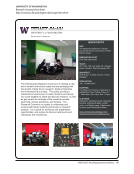SPEC Kit 327: Reconfiguring Service Delivery · 17
Impact of Service Delivery Implementation on
Personnel
The impact of changing service delivery on personnel
was central to the survey and deserves special consid-
eration here. The most common impact (reported by
68% of the libraries responding to questions 8 and 23)
was that existing staff, regardless of staff level, was
being moved to a new service point. The next most
common impact was reassigning personnel within
the library (46%). One quarter of the responding li-
braries reported that the number of positions in the
library had been reduced through attrition. Slightly
fewer than 10% reported that staff work hours had
been reduced. A fortunate few, slightly less than 20%,
reported that staff had been hired to fill newly cre-
ated positions as a result of the reported reconfigura-
tions. As can be seen in Figure 2 below, support staff
have experienced the most impact in all categories
but one, that of new hires, in which librarians were
the benefactors.
The descriptions of impacts on library personnel
varied across respondents although there were a few
common threads. By far the most often cited impact
was the need for training. For example, support staff
members were trained in providing reference service,
including activities such as the reference interview
and use of sources. Some librarians serving at con-
solidated service desks were instructed in the ins
and outs of circulation, interlibrary loan, reserves,
and other activities that commonly are transacted at
the circulation desk. As previously noted, this cross
training eliminated silos and helped personnel de-
velop insight into and appreciation of how the “other
guys” work.
Both moving staff to new service points and reas-
signing existing staff to other positions within the
library created some imaginative reporting relation-
ships, including dual-reporting lines for some of the
staff. If reporting relationships were not changed to a
different unit, at least new organization chart relation-
ships were established.
For librarians, a general trend was for fewer hours
of reference desk coverage while moving to either a
consultation or appointment mode for more in-depth
Figure 2. Impact of Service Delivery Implementation on Personnel
0
10
20
30
40
50
60
70
80
Support Staff
Other Professionals
Librarians
Other
impact
Hours
of
work
reduced
Staff
hired
to
fill
newly
created
positions
Position(s)
reduced
through
attrition
Existing
staff
reassigned
within
the
library
Existing
staff
moved
to
new
service
point
Impact of Service Delivery Implementation on
Personnel
The impact of changing service delivery on personnel
was central to the survey and deserves special consid-
eration here. The most common impact (reported by
68% of the libraries responding to questions 8 and 23)
was that existing staff, regardless of staff level, was
being moved to a new service point. The next most
common impact was reassigning personnel within
the library (46%). One quarter of the responding li-
braries reported that the number of positions in the
library had been reduced through attrition. Slightly
fewer than 10% reported that staff work hours had
been reduced. A fortunate few, slightly less than 20%,
reported that staff had been hired to fill newly cre-
ated positions as a result of the reported reconfigura-
tions. As can be seen in Figure 2 below, support staff
have experienced the most impact in all categories
but one, that of new hires, in which librarians were
the benefactors.
The descriptions of impacts on library personnel
varied across respondents although there were a few
common threads. By far the most often cited impact
was the need for training. For example, support staff
members were trained in providing reference service,
including activities such as the reference interview
and use of sources. Some librarians serving at con-
solidated service desks were instructed in the ins
and outs of circulation, interlibrary loan, reserves,
and other activities that commonly are transacted at
the circulation desk. As previously noted, this cross
training eliminated silos and helped personnel de-
velop insight into and appreciation of how the “other
guys” work.
Both moving staff to new service points and reas-
signing existing staff to other positions within the
library created some imaginative reporting relation-
ships, including dual-reporting lines for some of the
staff. If reporting relationships were not changed to a
different unit, at least new organization chart relation-
ships were established.
For librarians, a general trend was for fewer hours
of reference desk coverage while moving to either a
consultation or appointment mode for more in-depth
Figure 2. Impact of Service Delivery Implementation on Personnel
0
10
20
30
40
50
60
70
80
Support Staff
Other Professionals
Librarians
Other
impact
Hours
of
work
reduced
Staff
hired
to
fill
newly
created
positions
Position(s)
reduced
through
attrition
Existing
staff
reassigned
within
the
library
Existing
staff
moved
to
new
service
point






















































































































































































































